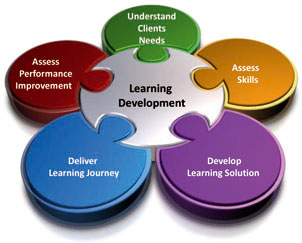Contact us to let us know you want to get the ball rolling! Then, the following model kicks in to action...
1. Understand Client's Needs
At the outset of a project it is necessary to establish clear terms of engagement and the client’s desired outcome. This can often be as simple as an initial meeting with our new client in order to get the ball rolling and, in other cases, a more detailed approach is called for and a much longer consultation period is required to clearly determine how the training intervention might impact the desired business objectives.
There are many forms of consultation including 1:1 interviews, on the job observation, data analysis, staff surveys, attending meeting, mystery shopping, quality call listening, customer surveys etc.
Once this fact-finding mission is complete we develop a proposal outlining the best learning and development solution for the business. This will have defined goals, definition and criteria. At this point the content and format can be agreed. This element takes into consideration operational demands, timelines, budget, infrastructure and culture.
The consultation phase ends with an agreed and well-defined performance development need that will be addressed via the training.
2. ASSESS SKILLS
Here at CINN we design tailored solutions that are specific to your company or team requirements using information gathered during the consultancy phase. This allows us to incorporate cultural language that will add value and encourage buy-in from the delegates during the delivery phase.
Training content is designed to challenge the delegates skill levels and will be a balance of theory and practical exercises with the emphasis on mirroring real work situations for maximum impact. This gives it relevance for the delegates and makes it tangible.
3. DEVELOP LEARNING SOLUTION
From experience, we've found that, quite often, our delegates already possess the skills required to perform their role, it's more about harnessing their experiences and empowering them with an understanding that the success of any training programme rests on the experience and attitude that they bring to the table.
We understand that it is behaviour that drives performance, so, rather than just talk about valued work behaviours; our delegates are challenged with demonstration. Creating the right learning environment and approach is crucial to ensure that the lessons learned translate to performance improvement and this also means that a variety of learning styles have to be catered for in every intervention.
Our training is obviously focused on experience and improving performance and so we use a mixture of traditional training methods, experiential training which can be indoor or outdoor, workshops, modular training programmes, conferences, one to one coaching, as appropriate to the business needs.
4. DELIVER LEARNING JOURNEY
Of course, the whole point is about translating learning into real performance improvements and many of our clients choose a post training 'on the job' coaching programme. This offers Kirkpatrick Level 3 results (see below)
These programmes allow us to work with you, not only to improve the performance of your teams but also ensure that your team leaders, coaches and managers underpin your investment and continue to improve team performance in the future. This is particularly important on a large-scale project where considerable changes in working practice may be required.
5. ASSESS PERFORMANCE IMPROVEMENTS
To ensure the best possible return on investment, we can evaluate the impact of the training on your business (see Kirkpatrick level 4 below). This might be a simple discussion or investigation of the changes or, if needed, a more in depth evaluation project where a comparison of results and data from the consultation phase is used to identify the performance improvements.
The Kirkpatrick Model
The Kirkpatrick Model is the worldwide standard for evaluating the effectiveness of training. It considers the value of any type of training, formal or informal, across four levels:
Level 1: Reaction The degree to which participants find the training favourable, engaging and relevant to their jobs
Level 2: Learning The degree to which participants acquire the intended knowledge, skills, attitude, confidence and commitment based on their participation in the training
Level 3: Behaviour The degree to which participants apply what they learned during training when they are back on the job
Level 4: Results The degree to which targeted outcomes occur as a result of the training and the support and accountability package
